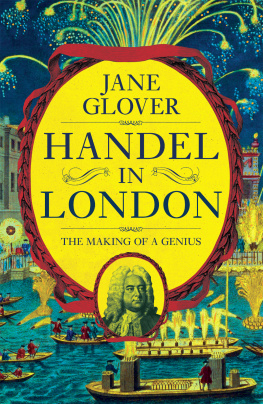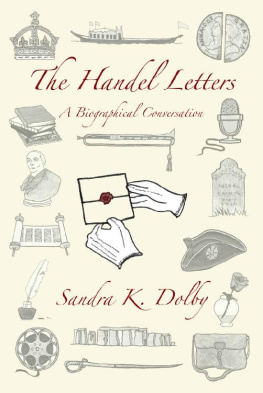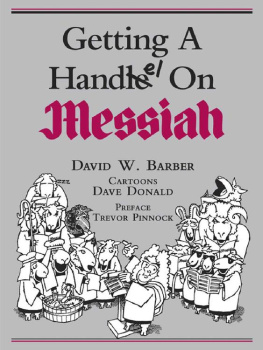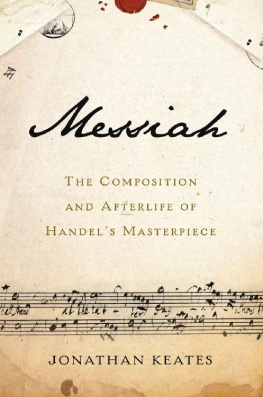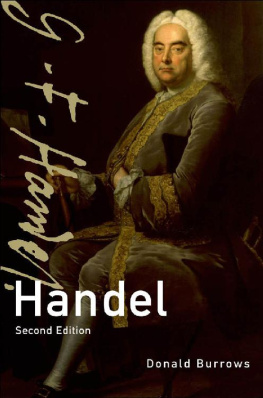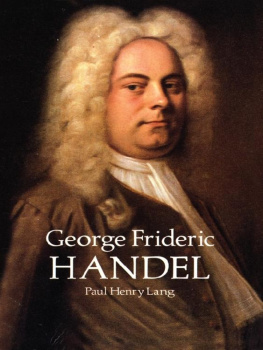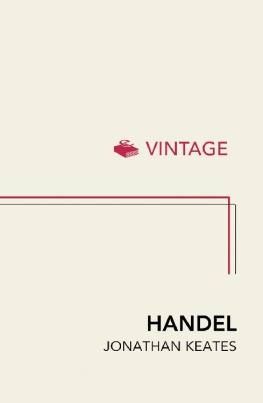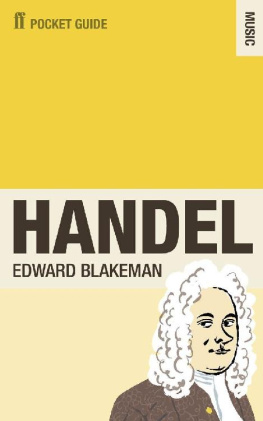THE LIVES OF
GEORGE FRIDERIC HANDEL
To evaluate the familiar, even over-familiar, story of Handels life could be seen as a quixotic endeavour. How can there be anything new to say? This book seeks to distinguish fact from fiction, not only to produce a new biography but also to explore the concepts of biography and dissemination by using Handels life and lives as a case study. By examining the images of Handel to be found in biographies and music histories the genius, the religious profound, the master of musical styles, the distiller into music of English sentiment, the glorifier of the Hanoverians, the hymner of the middle class, the independent, the prodigious, the generous, the sexless, the successful, the wealthy, the bankrupt, the pious, the crude, the heroic, the devious, the battler of ill-fortune, the moral exemplar and by adding new factual information, David Hunter shows how events are manipulated into stories and tropes. One such trope has been employed to portray numerous persons as Handels enemies regardless of whether Handel considered them as such. Picking apart the writing of Handels biographers and other reporters, Hunter exposes the narrative underpinnings the lies, confusions, presumptions, and conclusions, whether direct and inferred or assumed to show how Handels lives in biographies and histories have moulded our understanding of the musician, the man and the icon.
DAVID HUNTER is Music Librarian at the University of Texas at Austin.
Music in Britain, 1600 2000
ISSN 2053 3217
Series Editors:
BYRON ADAMS , RACHEL COWGILL AND PETER HOLMAN
This series provides a forum for the best new work in the field of British music studies, placing music from the early seventeenth to the late twentieth centuries in its social, cultural, and historical contexts. Its approach is deliberately inclusive, covering immigrants and emigrants as well as native musicians, and explores Britains musical links both within and beyond Europe. The series celebrates the vitality and diversity of music-making across Britain in whatever form it took and wherever it was found, exploring its aesthetic dimensions alongside its meaning for contemporaries, its place in the global market, and its use in the promotion of political and social agendas.
Proposals or queries should be sent in the first instance to Professors Byron Adams, Rachel Cowgill, Peter Holman or Boydell & Brewer at the addresses shown below. All submissions will receive prompt and informed consideration.
Professor Byron Adams,
Department of Music 061, University of California, Riverside, CA 925210325
email:
Professor Rachel Cowgill,
School of Music, Humanities and Media, University of Huddersfield,
Queensgate, Huddersfield, HD1 3DH
email:
Professor Peter Holman MBE,
School of Music, University of Leeds, Leeds, LS 2 9 JT
email:
Boydell & Brewer, PO Box 9, Woodbridge, Suffolk, IP 12 3 DF
email:
Previously published volumes in this series are listed at the back of this book
To all my fellow sufferers who
Carry that weight a long time
Boy, youre going to carry that weight
Carry that weight a long time
The Beatles, Abbey Road


Contents
Figures
By permission of the Marquess of Salisbury. Photograph and supplied by the Photographic Survey, The Courtauld Institute of Art, London.
Private collection/ Look and Learn/Peter Jackson Collection/Bridgeman Images.
Image and supplied by Gerald Coke Handel Collection, Foundling Museum, London.
Image supplied by the Visual Resources Collection, Fine Arts Library, The University of Texas at Austin.
National Portrait Gallery, London/De Agostini Picture Library/Bridgeman Images.
Private Collection. Image and supplied by the Handel House Museum, London.
Royal Collection Trust/ Her Majesty Queen Elizabeth II, 2015.
Image and supplied by Staats- und Universittsbibliothek, Hamburg, Germany.
National Portrait Gallery, London/De Agostini Picture Library/Bridgeman Images.
Fitzwilliam Museum, University of Cambridge/Bridgeman Images.
Image and supplied by the Victoria and Albert Museum, London.
Royal Collection Trust/ Her Majesty Queen Elizabeth II, 2015.
Royal Collection Trust/ Her Majesty Queen Elizabeth II, 2015.
Private Collection. Image and supplied by David Wilson Fine Art Limited.
Private Collection. Image and supplied by the Handel House Museum, London.
Image and supplied by the Victoria and Albert Museum, London.
Image and supplied by Westminster Abbey, London.
Tables
Acknowledgements
A lifetime in and around libraries and archives has not lessened my awe and admiration for them. The libraries that have proven especially beneficial to this undertaking are the British Library and the London Metropolitan Archives, The National Archives (Kew) (formerly the Public Record Office), the University of Texas Libraries (formerly the General Libraries) and the Harry Ransom Center (Austin, TX), the Huntington Library (San Marino, CA), the Beinecke Library of Yale University (New Haven, CT), the Bodleian Library (Oxford), the National Library and National Archives of Ireland (Dublin), the national libraries and archives of Wales (Aberystwyth) and Scotland (Edinburgh), the Public Record Office Northern Ireland (Belfast), university libraries (Aberdeen, Bangor, Bristol, Cambridge, Durham, Hull, Leeds, Manchester, Nottingham, York), and the vital and, in aggregate, largest supplier of new data, the network of county and city record offices across England and Wales.
This book is but small acknowledgment of the huge and continuing efforts made by the staffs of the libraries, archives, and record offices to acquire, catalogue, preserve, and offer for public use the vast array of family and other records upon which scholars depend. The construction of new facilities across Britain and Ireland to properly house archives and the people who organize and use them is a testament not only to the power of standards (formerly BS 5454) but also to the growing interest in the information that can be found in the materials, and the communities of supporters who insist upon their value.
In all, I have visited ninety-seven libraries and archives and in almost every one uncovered material that I have used in this book or the articles that preceded it, or have on file for future use. Handel-related material has been given to the Handel Collected Documents project. Much like a police detective faced with a complex case or an archaeologist investigating layer upon layer of evidence, so too does a researcher have tedious routine: hours, even whole days, spent identifying individuals, their families, and the locations of surviving records; thirty-four journeys to libraries and record offices that began and ended with a 5,000 mile transatlantic crossing; over 5,000 volumes or folders or boxes of archives summoned using a variety of computer or paper systems of varying efficiency; and sifting through what have seemed at times to be mountains of unyielding materials. The joy of the compensatory moments of discovery hardly finds its way into the following text but it is real nonetheless.
Financial support for research visits: grants and fellowships from The University of Texas at Austin, the British Academy, the Huntington Library, the Handel Institute (London), the Music & Letters Trust, and the Society for Theatre Research, have covered some of the cost of travel. It is no exaggeration to say that without this financial support, and releases from regular duties by my employer, the research would not have been possible.


